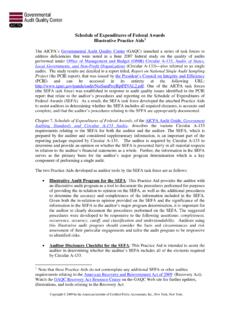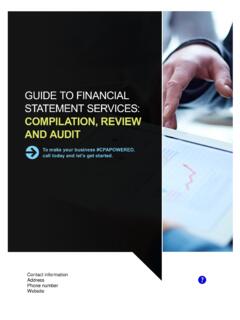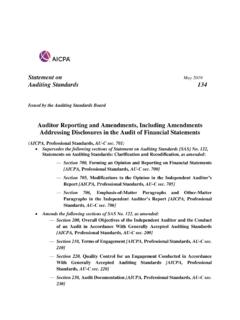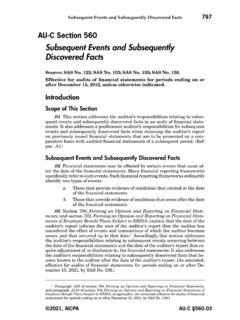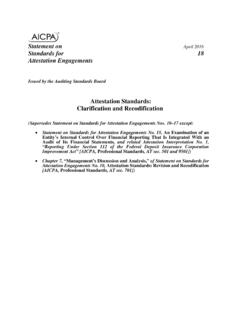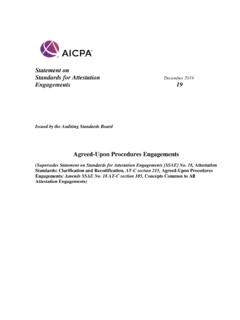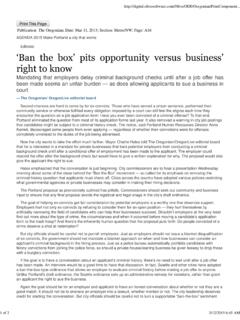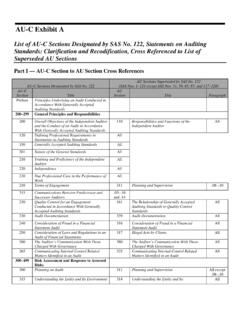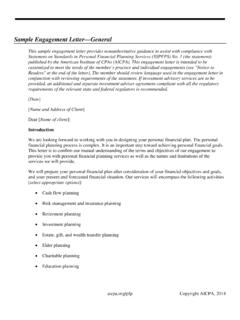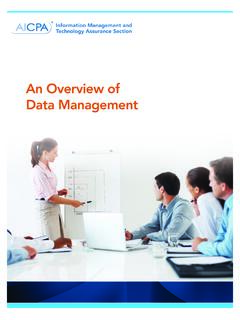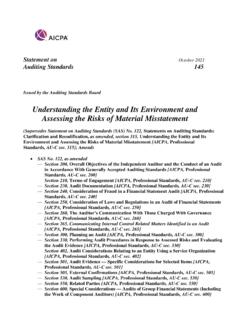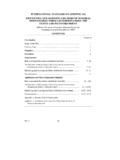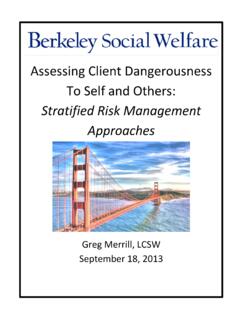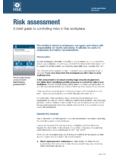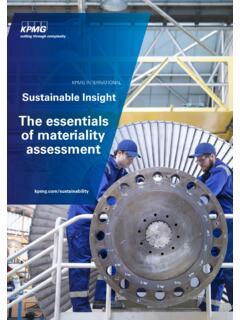Transcription of Understanding the Entity and Its Environment and …
1 Understanding the Entity and Its Environment1667AU Section 314 Understanding the Entity and ItsEnvironment and assessing the Risksof material misstatement (Supersedes SAS No. 55.)Source: SAS No. for audits of financial statements for periods beginning on or afterDecember 15, 2006. Earlier application is section establishes standards and provides guidance about im-plementing the second standard of field work, as follows:The auditor must obtain a sufficient Understanding of the Entity and its envi-ronment, including its internal control, to assess the risk of material misstate- ment of the financial statements whether due to error or fraud, and to designthe nature, timing, and extent of further audit importance of the auditor's risk assessment as a basis for further auditprocedures is discussed in the explanation of audit risk in section 312,AuditRisk and Materiality in Conducting an Audit.
2 See section 326,Audit Evidence,for guidance on how the auditor uses relevant assertions1in sufficient detailto form a basis for the assessment of risks of material misstatement and todesign and perform further audit procedures. The auditor should make riskassessments at the financial statement and relevant assertion levels basedon an appropriate Understanding of the Entity and its Environment , includingits internal control. Section 318,Performing Audit Procedures in Response toAssessed risks and Evaluating the Audit Evidence Obtained, discusses the au-ditor's responsibility to determine overall responses and to design and performfurther audit procedures whose nature, timing, and extent are responsive tothe risk assessments. This section should be applied in conjunction with thestandards and guidance provided in other sections.
3 In particular, the auditor'sresponsibility to consider fraud in an audit of financial statements is discussedin section 316,Consideration of Fraud in a Financial Statement following is an overview of this standard: Risk assessment procedures and sources of information about the en-tity and its Environment , including its internal sectionexplains the audit procedures that the auditor should perform to ob-tain the Understanding of the Entity and its Environment , including itsinternal control (risk assessment procedures). The audit team shoulddiscuss the susceptibility of the Entity 's financial statements to mate-rial assertionsare assertions that have a meaningful bearing on whether the account isfairly stated. For example, valuation may not be relevant to the cash account unless currency trans-lation is involved; however, existence and completeness are always relevant.
4 Similarly, valuation maynot be relevant to the gross amount of the accounts receivable balance, but is relevant to the relatedallowance accounts. Additionally, the auditor might, in some circumstances, focus on the presentationand disclosure assertions separately in connection with the period-end financial reporting Standards of Field Work Understanding the Entity and its Environment , including its section provides guidance to the auditor in understandingspecified aspects of the Entity and its Environment , and componentsof its internal control, in order to identify and assess risks of materialmisstatement, and in designing and performing further audit proce-dures. assessing the risks of material section providesguidance to the auditor in assessing the risks of material misstate- ment at the financial statement and relevant assertion levels.
5 Theauditor should: Identify risks by considering the Entity and its Environment , in-cluding relevant controls, and by considering the classes of trans-actions, account balances, and disclosures in the financial state-ments. Relate the identified risks to what could go wrong at the relevantassertion level. Consider the significance and the likelihood of material misstate- ment for each identified section also provides guidance to the auditor in determiningwhether any of the assessed risks are significant risks that requirespecial audit consideration or risks for which substantive proceduresalone do not provide sufficient appropriate audit evidence. The auditorshould evaluate the design of the Entity 's controls, including relevantcontrol activities, over such risks and determine whether they are ad-equate and have been implemented.
6 Section provides related documentation an Understanding of the Entity and its Environment is anessential aspect of performing an audit in accordance with generally acceptedauditing standards. In particular, that Understanding establishes a frame ofreference within which the auditor plans the audit and exercises professionaljudgment about assessing risks of material misstatement of the financial state-ments and responding to those risks throughout the audit, for example when: Establishing materiality for planning purposes and evaluatingwhether that judgment remains appropriate as the audit progresses. Considering the appropriateness of the selection and application of ac-counting policies and the adequacy of financial statement disclosures. Identifying areas where special audit consideration may be necessary,for example, related-party transactions, the appropriateness of man-agement's use of the going-concern assumption, complex or unusualtransactions, or considering the business purpose of transactions.
7 Developing expectations for use when performing analytical proce-dures. Designing and performing further audit procedures to reduce auditrisk to an appropriately low level. Evaluating the sufficiency and appropriateness of audit evidence ob-tained, such as evidence related to the reasonableness of manage- ment 's assumptions and of management's oral and written auditor should use professional judgment to determine the extentof the Understanding required of the Entity and its Environment , including itsAU the Entity and Its Environment1669internal control. The auditor's primary consideration is whether the under-standing that has been obtained is sufficient to assess risks of material mis-statement of the financial statements and to design and perform further auditprocedures.
8 The depth of the overall Understanding that the auditor obtains inperforming the audit is less than that possessed by management in managingthe Assessment Procedures and Sources of InformationAbout the Entity and Its Environment , Including ItsInternal an Understanding of the Entity and its Environment , includ-ing its internal control, is a continuous, dynamic process of gathering, updating,and analyzing information throughout the audit. Throughout this process, theauditor should also follow the guidance in section 316. As described in section326, audit procedures to obtain the Understanding are referred to asrisk as-sessment proceduresbecause some of the information obtained by performingsuch procedures may be used by the auditor as audit evidence to support as-sessments of the risks of material misstatement .
9 In addition, in performingrisk assessment procedures, the auditor may obtain audit evidence about therelevant assertions related to classes of transactions, account balances, or dis-closures and about the operating effectiveness of controls, even though suchaudit procedures were not specifically planned as substantive procedures or astests of controls. The auditor also may choose to perform substantive proceduresor tests of controls concurrently with risk assessment procedures because it isefficient to do Assessment auditor should perform the following risk assessment proceduresto obtain an Understanding of the Entity and its Environment , including itsinternal of management and others within the and inspectionThe auditor is not required to perform all the risk assessment procedures de-scribed above for each aspect of the Understanding described in paragraph.
10 , all the risk assessment procedures should be performed by the auditorin the course of obtaining the required addition, the auditor might perform other procedures where theinformation obtained may be helpful in identifying risks of material misstate- ment . For example, in cooperation with the Entity , the auditor may considermaking inquiries of others outside the Entity such as the Entity 's external legalcounsel or of valuation experts that the Entity has used. Reviewing informationobtained from external sources such as reports by analysts, banks, or ratingagencies; trade and economic journals; or regulatory or financial publicationsmay also be useful in obtaining information about the much of the information the auditor obtains by inquiries canbe obtained from management and those responsible for financial reporting,inquiries of others within the Entity , such as production and internal audit per-sonnel, and other employees with different levels of authority, may be useful inAU Standards of Field Workproviding the auditor with a different perspective in identifying risks of mate-rial misstatement .
